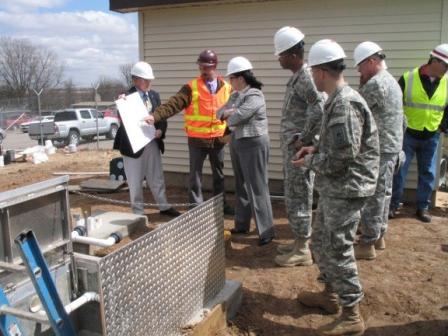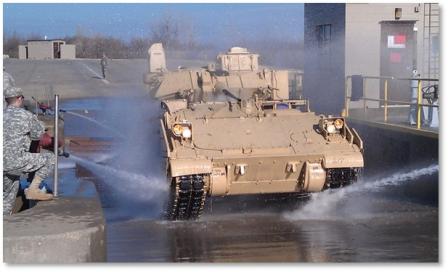Net Zero Projects
All Net Zero projects are geared toward helping the military installation or community become more sustainable and resilient with an emphasis on taking a systems approach. Projects must also advance the state of the science and address the needs of our partners and stakeholders. Projects are focused on three general topic areas: Water, Energy, and Waste, and the nexuses among them.
Project Topics:
Projects:


Demonstration of Water Reuse Technologies (Fort Riley, KS)
 Army and EPA officials examine the MBR water reuse treatment system during a site visit on Ft. Riley. (Photo credit: Chris Otto)
Army and EPA officials examine the MBR water reuse treatment system during a site visit on Ft. Riley. (Photo credit: Chris Otto)Today, we use drinking water for all of our household needs like taking showers, washing our cars, watering our lawns, and even flushing our toilets. Drinking water treatment is costly and energy-intensive; using potable water for all of our water needs is not a sustainable practice. In efforts to conserve potable water, water reuse (the beneficial reuse of treated wastewater) has become a research area of interest. Wastewater treatment typically occurs in a single, large centralized treatment facility in most towns and municipalities, leading to increased infrastructure and pumping costs to transport the treated water back to sites of reuse. Military installations and communities are seeking decentralized, energy-efficient alternatives to treat wastewater for reuse. In partnership with the Department of Defense (DoD) Environmental Security Technology Certification Program (ESTCP) Exit, EPA scientists are demonstrating and comparing different small-scale systems that tap into sewers and siphon wastewater to a nearby treatment unit for non-potable reuse. Successful demonstration of these cutting-edge technologies will provide reliable water reuse solutions to the U.S. military as well as communities and municipalities across the country seeking to reduce potable water consumption, costs, and energy use.

Containment and Control of Contaminated Wastewater (Fort Riley, KS)
 Soldiers at Ft. Riley wash a dirty vehicle returning from exercises; the wash water flows down through the wash rack and is trapped in containers below. EPA scientists are testing ways to decontaminate this water for reuse.
Soldiers at Ft. Riley wash a dirty vehicle returning from exercises; the wash water flows down through the wash rack and is trapped in containers below. EPA scientists are testing ways to decontaminate this water for reuse.
When military vehicles return from training exercises, soldiers clean them with high-pressure water cannons on wash racks that capture large volumes of dirty water containing grease, oils, metals, dirt, and/ or mud, etc. Even if the vehicle were to become contaminated with a chemical, biological, or radiological (CBR) agent, the wash water could ideally be treated and reused at this facility. This project tests a mobile water treatment trailer that inactivates and removes biological agents from large volumes of dirty wastewater so that the water can be reused for non-potable purposes. Results from this project will help advance technologies and treatment processes to decontaminate real-world dirty water. Data will be made available to cities, states, and DoD facilities that are seeking methods to treat large volumes of dirty water washed from vehicles, buildings, and personal protective equipment during an indoor or outdoor biological contamination event.

Monitoring Water Quality in Hospitals (Fort Riley, KS)
Hospitals and other large buildings have complex plumbing configurations that can result in slow-moving and temperature variant "hotspots" along the pipes that are more susceptible to water quality issues such as pipe corrosion, biolfilm growth, and increased water borne pathogens. These issues may be exacerbated by the increasing use of water-saving technologies (such as low-flow water fixtures) in large buildings by communities desiring to conserve water. The potential public health risk from waterborne pathogens is of special concern in hospitals, who serve vulnerable populations. This project seeks to develop a better understanding of how water quality in large hospital buildings can be optimized to protect public health while conserving water. EPA scientists will evaluate water quality data from an existing hospital and a new LEED-certified hospital with low-flow fixtures in Ft. Riley, KS to develop a site-specific water monitoring plan. The results of this study will provide a better understanding of how water-saving technologies impact water quality in large buildings and how to optimize water quality monitoring in these buildings. This knowledge can be applied to other hospitals, healthcare facilities, and large municipal buildings.

Green Infrastructure Demonstration and Education (Fort Riley, KS)
Increasing pressure on the nation’s water supply and infrastructure have prompted the development of new stormwater management practices referred to as green infrastructure (GI). The Army constructed a permeable pavement parking lot behind Seitz Elementary School on Fort Riley, KS, that EPA scientists are monitoring along with the school’s existing stormwater capture-and-use system to gain a better understanding of GI performance and how it changes with time. Students at the elementary school will be given opportunities to participate in the research and GI approaches to stormwater management will be incorporated into the school’s curriculum to help meet Next Generation Science Standards. ExitThis project will further the understanding of GI technologies for sustainable water resource management, reduce Fort Riley’s water footprint, and explore how GI can be used as an educational platform within schools and communities.

Water Conservation Education and Outreach (Fort Riley, KS)
While new, low-cost technological advancements are essential for improving our ability to manage water more efficiently, the social drivers of water demand and water uses practices must also be addressed to promote a balanced, long-term approach to water conservation. EPA scientists assessed the effectiveness of water conservation and outreach to curb water demand and change water use behavior of the Ft. Riley community. Outreach tools included general conservation education, targeted messages, prompts, water usage feedback from meters, and surveys. As a result of the interventions, there was an 11% decrease in residential potable water use and EPA now has a better understanding of water usage patterns and behaviors of families living on-post. The Army can use these results to establish water conservation interventions in communities at other bases, and civilian communities and municipalities can gain insight on effective mixes of targeted outreach and education to reduce water demand and change water use behavior.

Sustainable Materials Management (Columbia, SC)
Sustainable materials management, the use and reuse of materials in the most productive and sustainable way across the entire life cycle, requires incorporating expertise and perspectives from multiple sectors to achieve the Net Zero Waste goals. EPA initiated a multi-sector partnership to research the best options for sustainable materials management in Columbia, SC with an emphasis on organic waste management (such as food waste). A potential project being explored is co-digestion which diverts energy-rich organic waste materials (fats, oil, grease, and food scraps) from landfills and adds them to existing anaerobic digesters in wastewater treatment plants to produce energy in the form of methane.



Systems-Based Models for Sustainable Decision-Making (Aberdeen Proving Ground, MD and Fort Carson, CO)
Finding long-term solutions to Net Zero sustainability challenges requires optimally balancing the three pillars of sustainability that form the Triple Bottom Line: economy, society, and the environment. EPA is developing and testing systems-based models that account for the complex relationships between our economic, social, and environmental systems as military installations and communities pursue Net Zero Water, Energy, and Waste simultaneously. To achieve optimal resource management, EPA scientists are quantifying the benefits, trade-offs, and synergies associated with a coordinated approach to Net Zero. For example, technologies used to achieve Net Zero Water could be energy-intensive and negate any progress made toward Net Zero Energy. On the other hand, using waste diverted from landfills to produce energy works towards both Net Zero Waste and Net Zero Energy. In Aberdeen Proving Ground, MD, EPA scientists are applying a Triple Value Simulation (3VS) model to explore the environmental, economic, and societal outcomes of potential scenarios and solutions that could be implemented to achieve Net Zero goals on site. Similarly, in Ft. Carson, CO, EPA scientists are using another systems-modeling approach to analyze site-specific energy, water, and solid waste data and identify the interconnections, dependencies, and trade-offs among these sectors. These systems-modeling approaches can provide suggestions to decision-makers at other military installations and communities on how to optimally achieve their Net Zero goals.
